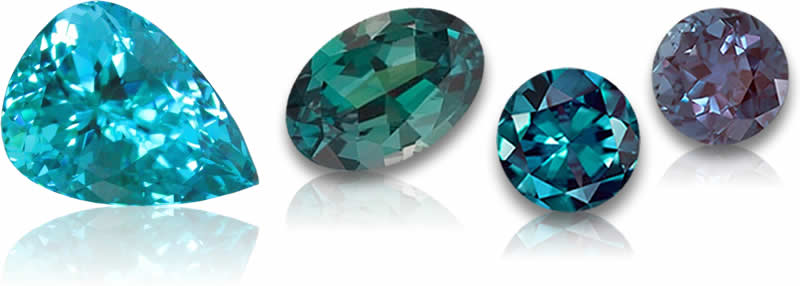Spotlight on Lesser-Known Gems Like Alexandrite, Paraiba Tourmaline, or Musgravite

While diamonds, rubies, and sapphires often steal the show in the gemstone world, there are some under-the-radar stones like alexandrite, Paraiba tourmaline, and musgravite that really grab the attention of collectors and fans. These gems stand out because of their scarcity and special features - you know, the kind that make you do a double-take. Often overlooked next to the big names, they bring their own visual charm and fascinating backstories from the Earth. In this piece, we're diving into what makes these gems special, from where they come from to their standout traits, and why they're worth paying attention to as of April 2025.
Alexandrite: The Color-Changing Wonder
Alexandrite is a type of chrysoberyl famous for its striking ability to switch colors, which is why people call it “emerald by day, ruby by night.” It was first found in the 1830s in Russia's Ural Mountains, and that shift from green or bluish-green under daylight to red or purplish-red in incandescent light happens thanks to tiny amounts of chromium in its makeup.
- Origins: Started out in Russia, but now it's also pulled from places like Brazil, Sri Lanka, and Tanzania.
- Properties: Scores an 8.5 on the Mohs hardness scale, so it's tough enough for everyday jewelry wear; it also shows strong pleochroism, meaning it looks different from various angles.
- Rarity: Top-notch pieces with a clear color shift are hard to come by, particularly from those tapped-out Ural sites.
That eye-catching change, plus its links to old Russian tsars, turns alexandrite into a real gem for anyone hunting for something out of the ordinary. Imagine wearing a stone that adapts to the light around you - pretty cool, right? For more details on this fascinating gem, check out our guide to alexandrite gemstone information and education or learn more about alexandrite's history and properties.
Paraiba Tourmaline: The Neon Treasure
When Paraiba tourmaline burst onto the scene in the 1980s from Brazil's Paraiba state, it blew everyone away with its bright neon blue-to-green shades. This tourmaline gets its glowing vibe from copper and manganese mixed in, a combo you don't see in other tourmalines.
- Origins: Mostly from Brazil, though later discoveries happened in Nigeria and Mozambique; the Brazilian ones are still the top pick for most folks.
- Properties: Hits 7-7.5 on the Mohs scale; that copper gives it a bright, almost glowing look that stands out.
- Rarity: Super scarce because the sources are limited - think one Paraiba for every 10,000 diamonds mined.
Its limited supply and bold colors have pushed prices up, making it a go-to for people who want jewelry that's vibrant and a bit unconventional.
Musgravite: The Elusive Rarity
Musgravite belongs to the taaffeite family and ranks as one of the planet's scarcest gemstones. It was uncovered in 1967 in Australia's Musgrave Ranges and at first got mixed up with taaffeite until experts spotted the magnesium that sets it apart. Colors run from greenish-gray to violet, keeping things subtle.
- Origins: Mainly Australia, with small amounts in Madagascar, Greenland, and even Antarctica.
- Properties: Hardness between 8 and 8.5; it's clear to somewhat see-through and has notable birefringence, which affects how light passes through.
- Rarity: Just a tiny number of gem-quality pieces are out there, turning it into a must-have for serious collectors.
With under 20 faceted examples known globally, musgravite's sheer exclusiveness puts it on a pedestal for those in the know.
Comparing the Gems
Here's a quick rundown in table form to see how these gems stack up:
| Gemstone | Primary Source | Unique Trait | Mohs Hardness | Avg. Cost (per carat, 2025) |
|---|---|---|---|---|
| Alexandrite | Russia, Brazil | Color change | 8.5 | $10,000 - $70,000 |
| Paraiba Tourmaline | Brazil | Neon glow | 7-7.5 | $5,000 - $20,000+ |
| Musgravite | Australia | Extreme rarity | 8-8.5 | $35,000+ |
Note: Prices can fluctuate a lot depending on the stone's quality, size, and what's happening in the market; these are rough estimates.
Why These Gems Matter
What sets these lesser-known gems apart is their uncommonness, striking looks, and one-of-a-kind geological traits. You've got alexandrite with its light tricks, Paraiba tourmaline lighting up with those radiant colors, and musgravite being so hard to find. They draw in collectors and jewelry makers looking for options beyond the usual suspects. Plus, since supplies are tight, they're seen as smart picks for investments, with values climbing as sources dry up.
Frequently Asked Questions
What makes alexandrite change color?
Alexandrite shifts colors due to trace amounts of chromium in its structure, appearing green in daylight and red under incandescent light.
Where is Paraiba tourmaline primarily sourced from?
It's mainly from Brazil's Paraiba state, with additional finds in Nigeria and Mozambique, but Brazilian stones are the most sought after.
How rare is musgravite compared to other gems?
Musgravite is extremely rare, with fewer than 20 known faceted gem-quality specimens worldwide, far scarcer than many other stones.
Are these lesser-known gems durable for jewelry?
Yes, they range from 7 to 8.5 on the Mohs hardness scale, making them suitable for rings, pendants, and other pieces with proper care.
Why might these gems be good investments?
Their rarity and limited deposits often lead to increasing values over time, appealing to collectors and investors alike.
Conclusion
Alexandrite, Paraiba tourmaline, and musgravite might not have the same household-name status as diamonds or emeralds, but their special qualities and limited numbers make them worth checking out. Whether you're a hobbyist or looking to invest, these stones let you hold onto some of the Earth's most unusual creations, mixing eye-catching features with tales of natural history. As more people get interested in distinctive gemstones, these overlooked wonders are set to gain more attention.

